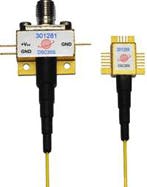Discovery Semiconductors high speed, extended InGaAs 2 micron photodiodes are increasingly being used for characterizing ultra-fast, mode-locked fiber laser at multiple wavelengths ranging from 1550 nm to 2100 nm. According to Dr. Grzegorz Sobon, at Wroclaw University of Science and Technology in Wroclaw, Poland, "We are using the DSC2-50S photodetectors for characterization of ultrafast, mode-locked fiber lasers. Broad operation bandwidth and high speed of the photodiode allows for acquisition of broadband radio-frequency spectra of mode-locked lasers operating at different wavelengths from the 1.55 – 2.1 μm range [1-3]. Therefore, we can use one photodiode to characterize different types of lasers (based on e.g. Erbium-, Thulium-, or Holmium-doped fibers). Additionally, the relatively high power handling is very advantageous while characterizing ultrashort (femtosecond) optical pulses with high peak power. Excellent sensitivity and low noise enabled us implementing very sophisticated measurement techniques, like dispersive Fourier transform for real-time shot-to-shot noise characterization of broadband mid-infrared supercontinuum sources [4]."
Added Mr. Abhay Joshi, President and CEO of Discovery Semiconductors,"This technology was funded through a Phase I and Phase II SBIR by the NASA Goddard Space Flight Center [5]. Since 2012, Discovery Semiconductors has been successfully commercializing this break-through technology, and are pleased to see the published results of Dr. Grzegorz Sobon's team. At present, our emphasis is to improve the Technology Readiness Level (TRL) of these devices via upcoming Material International Space Station Experiment (MISSE) space flights. We are encouraged by the support of NASA Langley Space Center in this endeavor."
References:
[1] G. Soboń, A. Duzynska, M. Świniarski, J. Judek, J. Sotor, M. Zdrojek, "CNT-based saturable absorbers with scalable modulation depth for Thulium-doped fiber lasers operating at 1.9 μm", Scientific Reports 7, 45491 (2017)
[2] G. Soboń, J. Sotor, T. Martynkien, K.M. Abramski, "Ultra-broadband dissipative soliton and noise-like pulse generation from a normal dispersion mode-locked Tm-doped all-fiber laser", Optics Express 24, 6156-6161 (2016)
[3] J. Sotor, M. Pawliszewska, G. Sobon, P. Kaczmarek, A. Przewloka, I. Pasternak, J. Cajzl, P. Peterka, P. Honzátko, I. Kašík, W. Strupinski, K. Abramski, "All-fiber Ho-doped mode-locked oscillator based on a graphene saturable absorber", Optics Letters 41, 2592-2595 (2016)
[4] M. Klimczak, G. Soboń, R. Kasztelanic, K. Abramski, R. Buczyński, "Direct comparison of shot-to-shot noise performance of all normal dispersion and anomalous dispersion supercontinuum pumped with sub-picosecond pulse fiber-based laser", Scientific Reports 6, 19284 (2016)
[5] "2.2-Micron, Uncooled, InGaAs Photodiodes and Balanced Photoreceivers up to 25-GHz Bandwidth," published in NASA Tech Briefs, March 1st, 2017
